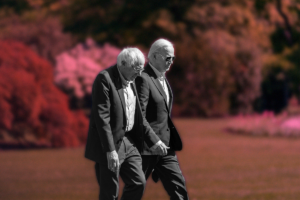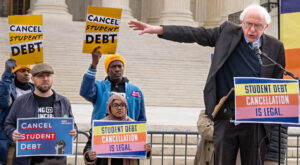Pundits Refuse to Let the Inane ‘Bernie Bro’ Myth Die
The Vermont senator boasts one of the most diverse coalitions in the field, but corporate media has its narrative and is sticking to it. New York Times columnist Bret Stephens. (YouTube screenshot)
New York Times columnist Bret Stephens. (YouTube screenshot)
 This article originally appeared on Salon.
This article originally appeared on Salon.
The nature of punditry makes it hard to tell which myths media personalities earnestly believe in, and which they perpetuate in bad faith. Consider the “welfare queen,” a villainous trope popularized by Ronald Reagan in stump speeches in the 1970s, and which never actually existed. Despite being a clear fiction, the idea was tantalizing both to politicians and pundits, and hence the welfare queen became embedded in culture. Pundits and politicians today still invoke the racist caricature, often through dog-whistles.
Why do some myths persist, or remain uncorrected by the media, while others dissipate? The short answer seems to be that when they serve a media narrative, or play on existing stereotypes, they grow to possess a power that goes beyond fact or truth. To this list of indefatigable myths, one might add the pernicious “BernieBro” — so ubiquitous a concept that it has its own Wikipedia article. The self-explanatory neologism was coined by Robinson Meyer in an Atlantic article in 2015 before being distorted by the Twittersphere and the punditry — something that Meyer later came to regret, as he felt the term he reified suffered from “semantic drift.”
But that was five years ago, before we had as much data on Sanders’ support base — which, as it turns out, should be sufficient to debunk the stereotype that Sanders’ support base consists entirely of a mythic tribe of entitled, pushy young millennial men. To wit: young women make up more of Sanders’ base than men. He polls especially high with Hispanic voters, far more so than with white voters; Hispanic voters also donated more money to him than any other Democratic candidate. Polls consistently show that nonwhite voters prefer him over the other candidates. Notably, the demographic group that likes Sanders the least is white men.
Moreover, of all the candidates, Sanders has taken in the most money from women. Many of Sanders’ female supporters bemoan how they are ignored by the mainstream press. “The ‘Bernie Bro’ narrative is endlessly galling because it erases the women who make up his base,” writer Caitlin PenzeyMoog opined on Twitter. “To paint this picture of sexism is to paint over the millions of women who support Sanders. Do you see how f**ked up that is?”
And yet. Even with all this demographic data on Bernie Sanders’ support base, many intelligent pundits and politicians persist with the myth. How do they justify it? They just know, apparently. But specifically, they feel it on Twitter.
Just one week ago, New York Times op-ed columnist Bret Stephens published a column with the headline “Bernie’s Angry Bros.” The column did not contain a shred of the aforementioned demographic data about Sanders’ support base, but rather was driven by a series of anecdotes supposedly proving his point about the irascible fans of the Vermont senator. Stephens’ main evidence, aside from social media anecdotes, was a story about Sanders supporters getting angry during or after the 2016 Nevada caucuses, believing they had been rigged against their candidate. (The idea that people might grow angry at being disenfranchised is horrifying to Stephens, probably because he is a well-insulated upper-middle class pundit for whom political decisions have no real material impact on his life — unlike the people in Nevada he disparages.)
The Daily Dot has a long feature listing pundits who have helped perpetuate the BernieBro narrative long after demographics showed his support base to be a multiracial, working-class coalition. Hillary Clinton apparently still believes that Sanders is tailed by a horde of “online Bernie Bros” who issue “relentless attacks on lots of his competitors, particularly the women,” as she said in a Hollywood Reporter interview just last month.
What could compel otherwise intelligent people to perpetuate a false and harmful narrative that essentializes Sanders supporters and erases their real and diverse identities?
Again, the answer to that is Twitter. Specifically, how Twitter is understood by journalists and pundits, and how it is wielded by angry people online.
The Skewed Demographics of Twitter
Twitter, unfortunately, informs the worldview of many of the country’s most elite pundits, and some of its politicians too. Opinion columnists like David Brooks and Bret Stephens (both of the New York Times) are excellent examples of pundits who, at various times, seem to see the world as refracted through the bluebird’s drinking glass.
The problem is, Twitter is very much not a representative sample of the world. It is not a zeitgeist; it is not a cross-section of the population.
It is hard to understand this, even for very smart people, because the corporation that runs Twitter tries very hard to make it seem like Twitter is the Alpha and the Omega, the beginning and the end of every cultural and political conversation.
But it is not true. However, the eponymous corporation behind Twitter profits from this perception of its platform as a zeitgeist. After all, the president is on it! Still, Twitter (the company) promotes this narrative of itself as where the conversation lives. They make money off of the lie that it is a representative cross-section of the world’s opinions and thoughts.
But a study of Twitter demographics say otherwise.
Pew Research polls from 2019 found that about 22% of the US population is on Twitter, and 44% of users are in the 18-24 age range. Linger on that for a second: a substantial proportion of the people getting in Bret Stephens’ mentions and making him upset may be scarcely older than children. Interestingly, Jonathan Chait of New York Magazine — a pundit with whom I rarely agree — is on the mark here.
“It is hard to exaggerate the degree to which the platform shapes the minds of professional political observers,” he wrote in a recent column. “Part of Twitter’s allure to insiders is that it creates a simulacrum of the real world, complete with candidates, activists, and pundits all responding to events in real time. Because Twitter superficially resembles the outside world’s political debate — it does, after all, contain the full left-to-right spectrum — it is easy to mistake it for the real thing.”
Here’s another stat from Pew that helps explain why Twitter is non-representative, a fount of professional-managerial class opinions: Thirty-one percent of Twitter users in the U.S. make more than $75,000, though only 23% of the country makes that much money. Likewise, 20% of U.S. Twitter users make less than $30,000, though about 28% of the country makes that much. The social media site is skewed towards wealthier Americans.
It’s too bad there aren’t as many statistics about who is active on the site. I’ve often suspected that people with white-collar office jobs and higher incomes (and thus more leisure time or computer time) are more steady tweeters, while those with manual labor jobs are not constantly perusing feeds and inserting themselves into the commentariat.
Angry People and Angry Brands
But the demographics of Twitter’s user base only say so much about the site’s distorted commentariat. There’s also the question of how people behave online, and why they behave so differently than they do in real life. There is a psychological reason why even very nice people are more likely to behave like assholes online. It is called the online disinhibition effect, and it is a big source of misery from pundits who do not understand it. The combination of three factors — the anonymity and pseudonymity of being online, the lack of accountability, and the indirect nature of online communications — make it so that online communication is dehumanizing, and often cruel.
Demographics and “real” users aside, Twitter — like most social media sites — has a huge number of accounts that aren’t even individuals. A great deal of Twitter users are instead are brands, spam accounts or bots who behave like actual people.
Because of this, getting in arguments with “people” on Twitter — or even just seeing Twitter as the so-called public sphere — is akin to arguing politics with a clown in a funhouse mirror. It is so heavily distorted — by corporate PR and marketing, by the way that people behave differently online, and even by powerful bad actors (whether state or individual) who can wield Twitter armies quickly and easily — as to be effectively useless as any sort of gauge of public opinion. It is a terrible place to gauge human behavior, or make broad pronouncements of what humans are like. And it’s an even worse place to get a sense of a politician’s support base.
I have a modest proposal for my peers in the journalism world: I would like to propose that anyone writing about a Twitter “mob” of any political ilk be required to include the previous paragraph in an asterisk at the bottom of their story. We should all be forced to include a disclaimer to clarify that it is impossible to make any kind of quantitative assessment of human behavior on Twitter because of how deeply skewed it all is — by hackers, PR professionals, paid influencers, intentional government or corporate misinformation campaigns, and the way the online disinhibition effect makes people act.
The Reactionary Mind at Work
After reading all this, someone with a personal story of a (purported) Sanders supporter being cruel to them online might still object. The Bernie Bro is real! This anecdote proves it.
But to say “a single candidate’s follower was mean, therefore I don’t support this candidate’s policies regardless of their actual political implications,” is a rhetorical fallacy. There are definitely individual assholes out there. Likewise, assholes can believe in good causes, and nice people can support terrible causes. It is a reactionary mistake to oppose a candidate — who represents a set of specific political positions poised to help or harm different social classes — on the basis of another’s individual behavior.
That means that the normalization of the BernieBro also diminishes the experience of those who are bullied by other candidates’ supporters. A video went around of an Elizabeth Warren supporter accosting two Sanders fans at the Iowa caucus; yet it didn’t get a lot of play because it didn’t reinforce existing stereotypes that we have about Warren’s supporters. Plenty of stories about online bullying by other candidates’ supporters are ignored because we lack a comparable stereotype to bundle them.
It would be one thing if Bernie Sanders — or any popular politician — told their supporters to be angry and menacing and threatening online, and then that behavior was reified on Twitter and in real life. But that has not happened with Sanders, nor with anyone else among the current crop of Democrats. You cannot draw a line from Sanders’ rhetoric to any of the stereotypes of BernieBros, because his rhetoric and voting records speaks to him being an egalitarian, a civil rights advocate and a compassionate progressive voice.
Your support matters…Independent journalism is under threat and overshadowed by heavily funded mainstream media.
You can help level the playing field. Become a member.
Your tax-deductible contribution keeps us digging beneath the headlines to give you thought-provoking, investigative reporting and analysis that unearths what's really happening- without compromise.
Give today to support our courageous, independent journalists.








You need to be a supporter to comment.
There are currently no responses to this article.
Be the first to respond.